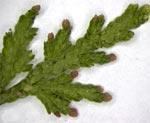 The lycophytes are an ancient lineage of vascular plants that arose about 400 million years ago. Lacking true leaves and roots, they are a key node of the plant evolutionary tree. The nuclear genome content of the lycophyte Selaginella moellendorffii (65-88Mbp) has the smallest genome size reported for a land plant species, about two-thirds that of Arabidopsis thaliana. A draft sequence of the S. moellendorffii genome will be useful to the plant biology community in many ways. First, as a clade intermediate between nonvascular plants (the algae and bryophytes) and all other vascular plants, it will serve as a reference genome for bridging large-scale genome comparisons. Having a compact genome, its sequence will be useful for cloning genes, annotating other genomes, discovering new genes, predicting regulatory regions of plant genomes, and constructing rooted and accurate gene and phylogenetic trees. Its sequence will also be a welcome resource for researchers interested in testing theories of plant evolution, particularly those relating to the evolution of traits fundamental to vascular plants, such as vascular tissue and lignification, root/stem/leaf organography, complex patterns of sporophyte branching, and the elaboration of reproductive structures, such as flowers, fruits, and seeds. Finally, its compact genome will help to define an ancient core of genes that are common to all vascular plants.
The lycophytes are an ancient lineage of vascular plants that arose about 400 million years ago. Lacking true leaves and roots, they are a key node of the plant evolutionary tree. The nuclear genome content of the lycophyte Selaginella moellendorffii (65-88Mbp) has the smallest genome size reported for a land plant species, about two-thirds that of Arabidopsis thaliana. A draft sequence of the S. moellendorffii genome will be useful to the plant biology community in many ways. First, as a clade intermediate between nonvascular plants (the algae and bryophytes) and all other vascular plants, it will serve as a reference genome for bridging large-scale genome comparisons. Having a compact genome, its sequence will be useful for cloning genes, annotating other genomes, discovering new genes, predicting regulatory regions of plant genomes, and constructing rooted and accurate gene and phylogenetic trees. Its sequence will also be a welcome resource for researchers interested in testing theories of plant evolution, particularly those relating to the evolution of traits fundamental to vascular plants, such as vascular tissue and lignification, root/stem/leaf organography, complex patterns of sporophyte branching, and the elaboration of reproductive structures, such as flowers, fruits, and seeds. Finally, its compact genome will help to define an ancient core of genes that are common to all vascular plants.
CSP project participants: Jo Ann Banks (proposer), Clint Chapple, Scott Jackson, Joe Ogas, Robert Pruitt, David Salt, and Dan Szymanski (Purdue Univ.); John Bowman and Sandra Floyd (Univ. of California, Davis); John Carlson, Dan Cosgrove, Claude dePamphilis, and Hong Ma (Pennsylvania State Univ.); Ned Friedman (Univ. of Colorado); and Dina Mandoli (Univ. of Washington).